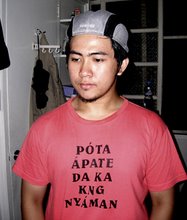We are in this period which communication theorist Marshall McLuhan calls the Global Village. With the high rate of cultural exchange as brought forth by information and communication technology, a poorly empowered cultural identity would not be able to contend in the battle for cultural survival.
With the presence of new media that make other cultures accessible, a child could get lost in the global village or join another cultural group (in simple terms, colonial or foreign mentality) consciously or subconsciously if he finds no distinction or prestige in the culture of his homeland.
This cultural confusion can be prevented though by making his native culture preferable and competent in this era of globalization and by making it thrive in these new media.
One of the observable symptoms of cultural deterioration in Pampanga is the gradual language shift happening to the younger generation, especially in the more industrialized areas like Angeles City, Mabalacat, and City of San Fernando. Tagalog is becoming the more preferred language, aside from English. This is evident in the youth’s heavy borrowings of Tagalog and English words in their daily conversations.
If left unopposed, Kapampangan is bound to be a dead language where no new generation speaks it anymore; only fossilized in heritage museums and libraries. Then, we will be able to appreciate how Kapampangan used to be, but can never really experience living with it. Memories won't suffice.
According to some alternative linguistic theories, language shift may be reversed if the speakers:
1. increase their prestige within the dominant community
2. increase their wealth
3. increase their legitimate power in the eyes of the dominant community
4. have a strong presence in the education system
5. can write the language down
6. can make use of electronic technology
We cannot do all of these at the same time, but taking things one by one will eventually lead us to the fulfillment of our vision.
A number of projects seeking to revive Kapampangan have been launched in the recent months. These establishments, however, are usually headed by the older Kapampangan generation.
While there is no hard evidence, it is the opinion of many observers, including yours truly, that there is a generation gap between the preference of the current Kapampangan youth and the pre-Mt. Pinatubo eruption generation. The said gap even extends to language preference, making young Kapampangan writers, musicians, speakers, filmmakers, etc. take little initiative to use their Amanung Sisuan in their craft.
If this is left unchallenged, the Kapampangan language will die in the next generation, because no one would pass it on.
Several months ago, I made rounds on the Internet, personally observing Kapampangan rock/alternative bands (from Mabalacat, Guagua, Angeles City, and San Fernando City) whether they played Kapampangan songs and wrote their own music in their native language or not.
Sadly, I saw NONE. The songs that they play and/or make are either in English or Tagalog.
In contrast with young Cebuano bands, the idea of "Kapampangan band music" -- as a whole -- has not had an identity of its own hugely because the musicians don’t even use the Kapampangan language in their music.
Cebuanos are known for Bisrock, or Bisaya Rock, and are patronized well in their region. In fact, they, along with other Visayan languages, are beginning to penetrate MYX, the Manila music video channel, without dropping their Sugbuanon.
I made rounds in cyberspace again and was able to view how Cebuano bands lead the youth—I’ve seen clips of well-attended rock concerts featuring Bisaya rockers singing original compositions. What melts my heart is that the audience even knows their songs, as they sing happily with the musicians.
In short, the Cebuano band scene is alive and kicking—as energized as the Manila band scene. This, on the side, makes the Cebuano language alive, too, in the realm of the Cebuano youth.
The GENUINE Kapampangan rock scene, is, in my opinion, dead, or is still premature, because it does not acknowledge the use of its
Amanung Sisuan. In several venues where Kapampangan bands are the main offering—such as Tigtigan Terakan, Fiestang Kuliat, and other beauty pageants, one would barely hear a single, originally composed Kapampangan song.
I’ve heard of some bands planning to compose some original Kapampangan rock songs, but with reasons such as discouragement from organizers and illiteracy, they never pushed through.
Clearly, young Kapampangan artists—despite their inherent talent—especially in the urban areas of Pampanga, refuse to express themselves in Kapampangan for a couple of reasons.
One reason why they don’t seem to use their language in making young, hip, and popular music is because it’s still taboo to use Kapampangan in more advanced media such as: blogs, websites, film, music, and TV and radio productions. I myself felt uncomfortable when I first heard ArtiSta. Rita’s pop song
Pamanuli. But as time went by, I learned to love it. And now, I’m even yearning for more stuff, more Kapampangan songs, in different genres!
Such poor perception roots from the displacement of Kapampangan in schools by the appointed National Language and the other official language English, making the youth think that Kapampangan is a language unfit for higher forms of art and science.
With no promising future in the proficiency or even just the continued use of Kapampangan, parents have been raising their children in Tagalog and English, because they are seen as the “languages of progress and/or prestige” in the country.
Having said all that, my proposal is: let’s spearhead projects that would campaign for the idea that the Kapampangan language is an equally rich and beautiful language, competent enough to be used in these modern times.
This Kapampangan rock album I'm directing seeks to provide a venue for our talented musicians to make them do new Kapampangan songs. I have contacted several bands and they are more than enthusiastic with the concept of making Kapampangan music.

It might be asked: why rock bands? This is in acknowledgment of the ability of bands to make their own music with freedom in asserting their respective styles. In other words, they are not merely singers, but song makers and performers in one package. They can perform independently and they basically decide for their own (minus the social or corporate constraints in some events).
Elders would sometimes cringe when they hear the word "rock," thinking it's all about drugs, skateboards, and body piercing. Rock is merely a music genre and should not be attached with explicit and vulgar lyrics.
Allow me to feature the response of the vocalist of one Kapampangan band called Tibuan when I contacted them for the album project:
My man, you rock.I've been looking for such group who can help boost what the Kapampangans should be boasting of—talent, and love for their language. I won't lie to you. Although I am a pure Kapampangan, I can't write in straight Kapampangan. I can't understand the older Kapampangan words but I know it's not that hard to go back and learn... I believe you when you say that our native language gets a little beating from other languages in the country....Well, thanks again and it's a pleasure to meet a fellow who advocates the ability of local talents and everything about our roots. -Ambo Lacap, Vocalist, Tibuan
The point of the project is to allow the Kapampangan language to enter the fast evolving popular culture as brought about by the global era; for if the youth fails to see the possibility of using Kapampangan in their surroundings, they would really not care to use Kapampangan to express themselves anymore.
With the songs preserved digitally on record, they will find it easy to penetrate local radio stations, Internet sites, and other forms of mass communication that can employ the use of recorded music.

In summary, we wish to materialize this project to achieve the following goals:
MUSIC: To release modern songs catering to the teenagers and young adults, who are into the following genres: pop, rock, mellow rock, alternative, reggae, jazz, emo, and rap
- To release Kapampangan songs for FM radio stations to play, for TV stations to use, and for locals to enjoy listening to
- To serve as additional to the currently small number of modern Kapampangan records.
- To propagate the idea that the Kapampangan language is not just for folk songs, church hymns, and schools, but also for mainstream genres
BANDS: To ignite the Kapampangan soul in local bands.
- To make them comfortable singing and playing their preferred music style in their mother language
- To increase the prestige attached to the Kapampangan language by young rock/alternative music lovers/makers
- To inspire the bands to compose their original Kapampangan songs in the future—thus, the birth of genuine Kapampangan rock.
- To make the bands sing with confidence appropriate Kapampangan songs in their individual gigs
- To mobilize the artistic youth and tap their skills to forward our advocacy on Kapampangan cultural heritage
INDUSTRY: To take initial steps in trying to establish a local music industry
- To give due recognition to our local music-making talents
- To give birth to a distinct brand of Philippine rock: K-Rock, which we may export outside the region, if already in a state of popularity, thereby making our mark in OPM (Original Pilipino Music).
- To propagate the idea that we can establish a strong music industry independent of Manila
- To attract local audience to patronize their kabalen
- To attract entrepreneurs to consider investing in local music production services and facilities
Even though the project is not yet done, I'd like to congratulate the following bands for participating in the project. After this, may they continue to take pride and develop our language through their musical skills. You have the electrocuting power of music -- our Indung Balen is calling out to you to serve and revolutionize!
Five Against The Wall

Amygdala

Asthma

Chocolate Factory

Cyclo

Late Jammers

Mernuts

Mental Floss

T.H.E.M.

Tibuan

Neophytes

Dialogo

Chilimansi
and
High Times




























